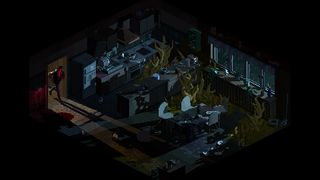Holstin is a Polish survival horror game that upends everything I thought I knew about camera perspective, and the vibes are flawless
Set in a small Polish town in 1992, Holstin promises to be like nothing I've played before in more ways than one.
There are two reasons why I was all-in on Holstin fewer than 20 seconds into its PC Gaming Show: Most Wanted trailer. The first is probably obvious: the technical magic that lets it transition from an isometric, exploratory horror game to an over-the-shoulder shooter without a hitch. I'm not sure I've ever seen it done before, and certainly not with this much pizzazz. It's like watching Baldur's Gate become Resident Evil 4; you can't help but be impressed.
The second? That kielbasa. Holstin comes from Polish studio Sonka, and it wears its cultural roots on its bloodied sleeve. The game takes place in the rural Polish town of Jeziorne-Kolonia in November 1992. Our protagonist and his period-appropriate moustache is visiting to uncover the fate of his friend Bartek, but arrives to discover the entire area overtaken by the living dead and all manner of monstrous, many-tendrilled things.
Things which you will then proceed to battle and baffle using whatever means you have to hand. Sonka president and Holstin's game director Rafał Sankowski tells me that the studio is hoping to achieve a natural flow between dialogue—which you can hear in either Polish or English—puzzles, and action throughout Holstin. "There will be a lot of action, there will be hordes of enemies, bosses and mini bosses," says Sankowski, "Between or even in the middle of all that, NPCs will talk to you and puzzles will block your way."
In some instances, "an enemy encounter is a puzzle" in and of itself, says Sankowski. The way he describes it, Holstin sounds like it's leaving room for players to find an approach that suits them. Start shooting, chuck a Molotov, or sneak around. They all have their advantages and drawbacks, not least of which—if you're throwing firebombs—is the fact that fire will spread with wild abandon. "If you throw a Molotov inside a house with a wooden floor… good luck," warns Sankowski.
There's still gonna be plenty of gunplay, though, don't you worry. "There's this opinion that survival horror isn't about shooting or combat, but I don't really agree," Sankowski tells me, pointing out how many guns and enemies you can find across Resident Evil, Silent Hill and Dead Space. Rather than downplaying combat, Holstin wants to make it "more about survival and less about power fantasy."
Polish the game
But Holstin's vibes are what makes it truly appealing to me. Small-town Poland in 1992, just a few years after the collapse of state socialism, is an inexplicably underrepresented locale in videogames. "It was a wild period," says Sankowski, "Politically, culturally and technologically. Times of great hope and even bigger disappointment for a big part of society. Such reality creates a lot of space for drama, intriguing characters, and unusual circumstances, especially when mixed in with a small-scale zombie apocalypse."
It's a time Holstin's devs remember, too. "Because we grew up in [the] Polish '90s, we can convey that atmosphere much better… than if the game was happening anywhere else," says Sankowski. He calls small towns—like the one Holstin takes place in— "Poland B," the hinterlands beyond more recognisable places like Krakow or Warsaw. "To us, these small towns are Poland… Łęczyca, Jędrzejów, or Grójec are where our minds go when thinking of horror."

He doesn't mean to imply that Polish small towns are all home to their own "masked cannibal living in a small shack in the woods," but rather that they possess a unique "oppressive atmosphere" that Holstin tries to embody. "The feeling of otherness, being pulled out of the world—not only in terms of distance," that's what Sonka's going for here, by combining their own cultural experience with the studio's "2XD rendering" system.
That's the rendering system you can thank for Holstin's perspective switching, as well as all the pustules and buboes that sprout on the skin of its undead. Based on what we've seen so far, it works very well indeed, but it sounds like a heck of a lot of work for the studio to pull off.
Sankowski says that even creating a simple object like a table requires generating eight "hand-pixelled" bits of art for the game's fixed camera angles, creating textures based on each of them just in case you go into third-person mode, making a 3D model, and generating a whole bunch more textures for good luck. "All that," says Sankowski, "so we can display an actual handcrafted pixel art most of the time."
I think it pays off, though. I've wanted more time with Holstin since I first laid eyes on it, in no small part because of all that work. Hopefully we'll get our hands on it soon. Until then, though, you can find Holstin and its playable demo over on Steam.
The biggest gaming news, reviews and hardware deals
Keep up to date with the most important stories and the best deals, as picked by the PC Gamer team.

One of Josh's first memories is of playing Quake 2 on the family computer when he was much too young to be doing that, and he's been irreparably game-brained ever since. His writing has been featured in Vice, Fanbyte, and the Financial Times. He'll play pretty much anything, and has written far too much on everything from visual novels to Assassin's Creed. His most profound loves are for CRPGs, immersive sims, and any game whose ambition outstrips its budget. He thinks you're all far too mean about Deus Ex: Invisible War.
Most Popular







